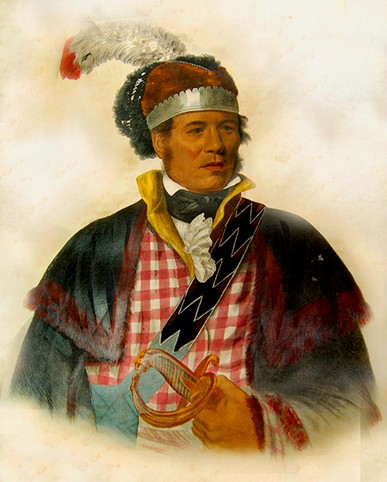Battle of Autossee
Introduction
Text-to-speech Audio
Images
Lower Creek leader William McIntosh, who led U.S.-allied Creeks at the Battle of Autossee

General John Floyd commanded the American forces at the Battle of Autossee

Backstory and Context
Text-to-speech Audio
In 1813, Creek Nation found itself mired in violence. In response to white encroachment on Creek lands (much of which was in present day in Alabama), a religious movement emerged among certain Creek towns that called for the rejection of white culture and hostility to white settlers. These so-called “Red Sticks” (named for the red-painted war clubs favored by the Creeks) clashed with a more peaceable faction of their tribe who enjoyed positive relationships with Americans. These two factions descended into civil war. In July and August, the conflict spilled over; American militia attacked Red Sticks at the Battle of Burnt Corn, and the Red Sticks responded by attacking and massacring several hundred American settlers and enemy Creeks at Fort Mims.
Unable to ignore the conflict, the United States launched a campaign to bring the rebellious Red Stick Creeks to heel. General Andrew Jackson would lead Tennessee militia south into Creek Nation while General John Floyd would push westward with Georgian militia. The pincer movement was designed to decisively defeat Red Stick forces and destroy their major villages.
Starting from Fort Mitchell along the Georgia-Alabama border, General John Floyd’s force struck westward along the Federal Road in late November. His force consisted of approximately 950 Georgian infantry and cavalry militia, accompanied by a pair of brass artillery pieces. Also joining Floyd’s expedition were U.S.-allied Creek Indians under the commands of Creek leaders William McIntosh and Mad Dog.
The American militia army targeted Autossee. A well-known village dating back to the Mississippian mound-builders, by 1813 Autossee (also known as Atasi) was a major Creek village consisting of several hundred houses along the Tallapoosa River, near its junction with Calabee Creek. The village served as a gathering point for Red Stick warriors, and there were reportedly 1,500-2,000 Red Sticks under the command of Coosa Micco ready to defend the village. Several hundred more Red Sticks under the command of Paddy Walsh were several miles nearby as possible reinforcements.
As General Floyd advanced on the town, he intended to attack the village from two sides with his militia. William McIntosh’s Creek allies would cross the Tallapoosa River and prevent any Red Sticks from fleeing by water. Yet as Floyd’s men advanced towards Autossee on the cold morning of November 29, they quickly discovered their plan had gone awry. There was actually a second Creek village just 500 yards downriver; its presence prevented Floyd’s two-pronged attack plan. Moreover, the Tallapoosa’s deep and icy cold waters prevented the allied Creeks from crossing. Instead, Floyd was forced to attack both villages directly. McIntosh’s Creeks would cross Calebee Creek to block the Red Stick’s escape route (although the Red Sticks could still escape across the Tallapoosa).
The Red Sticks were prepared for the American attack. The American militia advanced directly across an open plain towards the Indians in front of Autossee. Artillery thundered and militia cavalry supported the Americans’ flanks. The Red Sticks held firm, taking the American charge head-on. The Americans were repulsed, sustaining casualties including General John Floyd, who was shot in the leg but remained on the field in command.
Yet while the Americans were driven back from Autossee, they managed to penetrate the Red Stick line in front of the Creek village downriver. Slowly the entire Red Stick line began to collapse. Although the Red Sticks began to defend the village house by house, American artillery quickly drove them out. As American forces entered Autossee, they massacred a number of Red Sticks, including civilians. They looted the town of valuables and set it alight.
The retreating Red Sticks found shelter amid the brush of the Tallapoosa River’s banks. The bank dropped in such a way that it provided the Red Sticks with a ready made trench. From this protected but precarious position with the river to their backs, the Red Sticks made a fierce stand that allowed many of their comrades to escape. As General Floyd reported, “the fire on both sides was tremendous; many were killed.”[2]
As the Red Sticks fended of the Americans, General Floyd determined at the moment to regroup and withdraw. Though his forces were winning the battle, he had legitimate reasons to retreat. His men had defeated the Red Stick army and burned Autossee to the ground, which were his immediate objectives. His supplies were running low, he had a number of wounded on hand, and he worried that more Red Stick reinforcements might arrive. His forces disengaged and withdrew. He moved a few miles off and setup a temporary camp to allow his wounded to be treated and to bury the dead.
The allied Creeks continued looting Autossee. It was a mistake. Paddy Walsh arrived with Red Stick reinforcements and attacked his unsuspecting U.S. allied brethren. Creek fought Creek in Autossee, and the Red Sticks were surrounded. The Georgian rear guard came to the rescue, charging the enemy on a small height known as Heydon’s Hill and allowing their Red Stick allies to escape. General Floyd’s forces withdrew safely to Fort Mitchell in the following days.
The Battle of Autossee proved bloody for both sides. The militia suffered eleven killed and fifty-four wounded (including General Floyd); their Creek allies suffered an unknown number of casualties. Although Floyd reported the Red Sticks lost 200 dead and even more wounded, the Red Sticks reported 80 dead and over 100 wounded (a likelier figure). In the bigger picture, the battle’s result was inconclusive. The Americans drove the Red Sticks back and burned Autossee. Their invasion encouraged several more Creek towns to cast their lot with the United States. Yet the Red Sticks’ battlefield performance was encouraging, having repulsed the enemy’s initial charge. They also held the battlefield, as the Americans ultimately cheated.
The conclusive end to the Creek War came in March 1814, when General Andrew Jackson decisively defeated the Red Sticks at the Battle of Horseshoe Bend. Despite the fact that a number of Creeks allied with the United States, Andrew Jackson forced the Creek Nation to cede over 20 million acres of land to the United States through the Treaty of Fort Jackson.
Unfortunately, the site of the battle today rests on private property and nothing stands to commemorate the Battle of Autossee.
Sources
1. Claire M. Wilson, "Battle of Autossee." October 8, 2014. Encyclopedia of Alabama. Web. Accessed November 30, 2020. http://encyclopediaofalabama.org/article/h-3079
2. Howard T. Weir. A Paradise of Blood: The Creek War of 1813-1814. Yardley, PA: Westholme Publishing, 2016.
3. John R. Elting. Amateurs, to Arms! A Military History of the War of 1812. New York: Da Capo Press, 1995.
Birmingham Public Library, via Encyclopedia of Alabama: http://encyclopediaofalabama.org/article/m-2216
University of Georgia Libraries, via the Encyclopedia of Alabama: http://www.encyclopediaofalabama.org/article/m-7404
